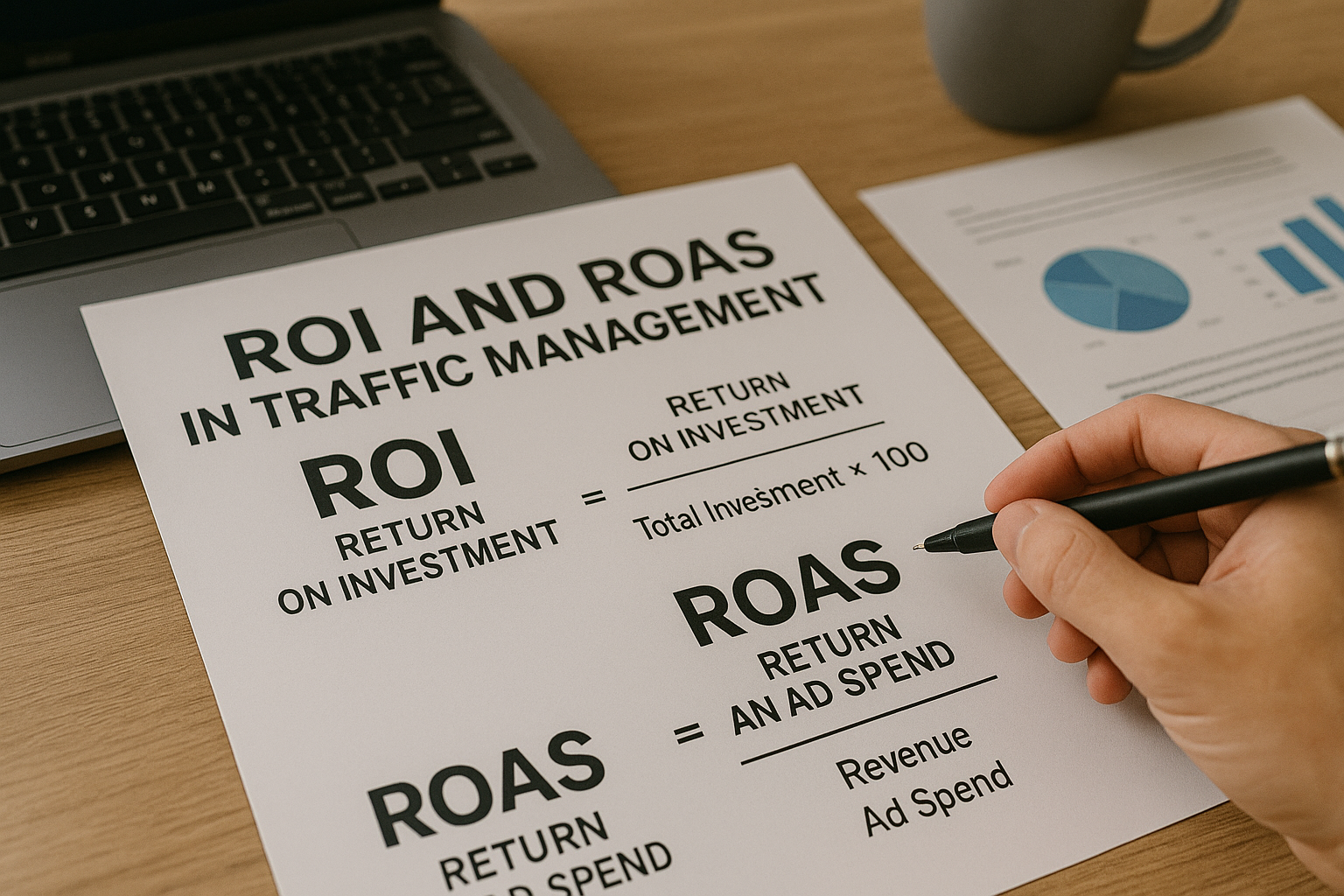If you’re new to traffic management, you’ve probably heard terms like ROI and ROAS thrown around. These acronyms are essential to understanding whether your campaigns are making money — or just spending it.
In this article, we’ll break down what ROI and ROAS mean, why they’re critical in digital marketing, how to calculate them, and how to use them to improve your results and client relationships.
Let’s dive in.
What Is ROI?
ROI stands for Return on Investment.
It’s a measure of how much profit you make from your investment. In traffic management, ROI tells you whether a campaign is profitable when all costs are considered — not just the ad spend.
Formula:
ROI=ProfitTotalInvestment×100ROI = \frac{Profit}{Total Investment} \times 100ROI=TotalInvestmentProfit×100
Or more specifically: ROI=Revenue−TotalCostsTotalCosts×100ROI = \frac{Revenue – Total Costs}{Total Costs} \times 100ROI=TotalCostsRevenue−TotalCosts×100
Example:
- You spent $1,000 on ads
- You made $2,500 in revenue
- Your product cost, tools, and services add up to $700
- Total cost = $1,000 (ads) + $700 = $1,700
ROI=2,500−1,7001,700×100=47.05%ROI = \frac{2,500 – 1,700}{1,700} \times 100 = 47.05\%ROI=1,7002,500−1,700×100=47.05%
You made a 47% return on your total investment.
What Is ROAS?
ROAS stands for Return on Ad Spend.
It’s more specific than ROI — it tells you how much revenue you earned for every dollar spent on ads, ignoring other business costs.
Formula:
ROAS=RevenueAdSpendROAS = \frac{Revenue}{Ad Spend}ROAS=AdSpendRevenue
It’s usually expressed as a ratio.
Example:
- Ad Spend: $1,000
- Revenue: $2,500
ROAS=2,5001,000=2.5ROAS = \frac{2,500}{1,000} = 2.5ROAS=1,0002,500=2.5
This means that for every $1 you spent, you made $2.50.
Key Differences Between ROI and ROAS
| Metric | Focuses On | Includes Costs? | Best For |
|---|---|---|---|
| ROI | Total business return | ✅ Yes | Understanding overall profitability |
| ROAS | Ad performance | ❌ No | Optimizing ad campaigns |
Think of ROAS as a marketing performance metric and ROI as a business health metric.
Why ROAS Is Critical for Traffic Managers
As a traffic manager, your job is to generate results through paid advertising. That means:
- Maximizing return for every dollar spent
- Scaling what’s working
- Cutting what’s not
ROAS gives you a direct measure of how well your campaigns are performing.
A high ROAS means:
- The audience is responding well
- The creatives are converting
- The funnel is working
A low ROAS means something is broken — and it’s your job to fix it.
What Is a Good ROAS?
It depends on your client’s industry, margins, and goals, but here are general benchmarks:
| Industry | Average ROAS |
|---|---|
| E-commerce | 2x – 4x |
| Info products | 2x – 10x+ |
| Lead generation | 1.5x – 3x |
| Local services | 2x – 5x |
| High-ticket offers | 3x – 8x |
The higher the profit margin, the lower the ROAS you need to break even.
Example:
If you sell a product that costs $20 but only profits $5, your ROAS must be much higher than someone selling a $1,000 service with $800 profit.
How to Improve ROAS
Now that you understand what it is, let’s look at how to improve your return on ad spend.
1. Improve Ad Creatives
- Use high-quality visuals
- Test videos and carousels
- Write clear, benefit-driven copy
- Add social proof and urgency
2. Target the Right Audience
- Refine interest targeting
- Use lookalike audiences
- Exclude unqualified users
- Use retargeting for warm leads
3. Optimize Landing Pages
- Match your ad message to the page
- Make the CTA clear and prominent
- Speed up page load time
- Remove distractions or unnecessary fields
4. Increase AOV (Average Order Value)
- Offer bundles or upsells
- Add “frequently bought together” options
- Use limited-time offers or minimum cart bonuses
5. Reduce Cart Abandonment
- Send reminder emails or retargeting ads
- Offer free shipping
- Simplify checkout process
Every 1% improvement can add up to a massive increase in ROAS over time.
Why ROI Still Matters (Especially for Clients)
While ROAS helps you as a traffic manager, clients care about ROI.
They don’t just want to know how much revenue you generated — they want to know how much money they made after costs.
That means factoring in:
- Product cost
- Shipping
- Platform fees (Shopify, Stripe, etc.)
- Your service fee
- Tools and software
When pitching or reporting to clients, use ROAS to show campaign success and ROI to show business impact.
Reporting Example: Clear Communication
Here’s how you can present results to a client:
“This month, we spent $2,000 on Meta Ads and generated $6,500 in sales. That’s a ROAS of 3.25. After subtracting your product and shipping costs, your net profit is $2,500 — giving you a 125% ROI.”
This kind of clarity builds trust and shows that you’re not just spending money — you’re managing investments.
Tools to Track ROAS and ROI
- Meta Ads Manager – See ROAS in your reports
- Google Ads Reports – Include conversion value tracking
- Google Analytics – Set up eCommerce tracking and goals
- Looker Studio (formerly Data Studio) – Build custom dashboards
- Shopify Analytics – Great for e-commerce brands
- Manual Calculation – For clients with offline sales or spreadsheets
Make sure conversion tracking is properly installed before relying on ROAS numbers.
Final Thoughts: Master the Metrics, Master the Job
Understanding and applying ROI and ROAS makes you more than just someone who clicks buttons — it turns you into a strategic partner for any business.
Here’s a recap:
- ROAS = revenue from ads / ad spend
- ROI = (revenue – all costs) / total costs
- Use ROAS to optimize ad performance
- Use ROI to evaluate total campaign profitability
- Report both clearly and confidently to clients
As you grow in your traffic management journey, you’ll find that your ability to track and improve these two metrics will directly impact your income and reputation.
